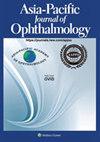三萜皂苷介导的老年性黄斑变性(AMD)视力缺陷恢复:双盲、安慰剂对照、随机临床试验
IF 4.5
3区 医学
Q1 OPHTHALMOLOGY
引用次数: 0
摘要
目的:在年龄相关性黄斑变性(AMD)中,由于视黄醇通过严重改变的Bruch膜的传递减少,漂白剂后杆状光感受器敏感性(S2梯度)的恢复率降低。由于已知三萜皂苷可以改善布鲁氏转运,我们已经评估了它们在逆转AMD视力缺陷方面的可能用途。设计:双盲、安慰剂对照的随机临床试验。方法:共招募11名AMD患者和7名年龄匹配的对照受试者进行一项小型原理验证研究。使用Humphrey Field analyzer获得暗适应曲线并评估S2梯度。在基础测定S2梯度后,开始口服皂苷(200 mg/天)或安慰剂方案,持续4个月。在2个月和4个月时重新评估S2梯度。结果:AMD队列的基础S2梯度为0.41 ± 0.24 dB/min,对照组为1.44 ± 0.1 dB/min。经过两个月的皂苷治疗,AMD患者的S2梯度改善为0.92 ± 0.23 dB/min (P )。结论:口服补充皂苷可逆转AMD患者的S2梯度降低。布鲁氏传递特性的改善有望减缓、停止或逆转AMD的进展。本文章由计算机程序翻译,如有差异,请以英文原文为准。
Triterpenoid saponin–mediated recovery of visual deficits in age-related macular degeneration (AMD): Double-blind, placebo-controlled, randomised clinical trial
Purpose
Recovery rate of rod photoreceptor sensitivity (S2 gradient) following a bleach is reduced in age-related macular degeneration (AMD) due to diminished delivery of retinol across a grossly altered Bruch's membrane. Since triterpenoid saponins are known to improve transport across Bruch's, we have assessed their possible use for reversing the visual deficits in AMD.
Design
Double-blind, placebo controlled randomised clinical trial.
Methods
Altogether 11 AMD patients and seven age-matched control subjects were recruited to undertake a small proof-of-principle study. Dark adaptation curves were obtained and S2 gradients evaluated using a Humphrey Field Analyser. Following basal determination of S2 gradients, oral supplementation of saponins (200 mg/day) or placebo regime was instigated for a period of 4 months. S2 gradients were re-evaluated at two and four months.
Results
Basal S2 gradients of the AMD cohort were determined as 0.41 ± 0.24 dB/min and those of the control subjects as 1.44 ± 0.1 dB/min. After two months of the saponin treatment, AMD subjects showed improved S2 gradients of 0.92 ± 0.23 dB/min (P < 0.005) with a further increase to 1.35 ± 0.19 dB/min at four months (P < 0.01), the latter not being significantly different from control subjects. S2 gradients in placebo subjects were unaltered.
Conclusions
Oral supplementation with saponins results in reversing the reduced S2 gradients in AMD. This improvement in the transport properties of Bruch's is expected to slow, halt or reverse the progression of AMD.
求助全文
通过发布文献求助,成功后即可免费获取论文全文。
去求助
来源期刊

Asia-Pacific Journal of Ophthalmology
OPHTHALMOLOGY-
CiteScore
8.10
自引率
18.20%
发文量
197
审稿时长
6 weeks
期刊介绍:
The Asia-Pacific Journal of Ophthalmology, a bimonthly, peer-reviewed online scientific publication, is an official publication of the Asia-Pacific Academy of Ophthalmology (APAO), a supranational organization which is committed to research, training, learning, publication and knowledge and skill transfers in ophthalmology and visual sciences. The Asia-Pacific Journal of Ophthalmology welcomes review articles on currently hot topics, original, previously unpublished manuscripts describing clinical investigations, clinical observations and clinically relevant laboratory investigations, as well as .perspectives containing personal viewpoints on topics with broad interests. Editorials are published by invitation only. Case reports are generally not considered. The Asia-Pacific Journal of Ophthalmology covers 16 subspecialties and is freely circulated among individual members of the APAO’s member societies, which amounts to a potential readership of over 50,000.
 求助内容:
求助内容: 应助结果提醒方式:
应助结果提醒方式:


